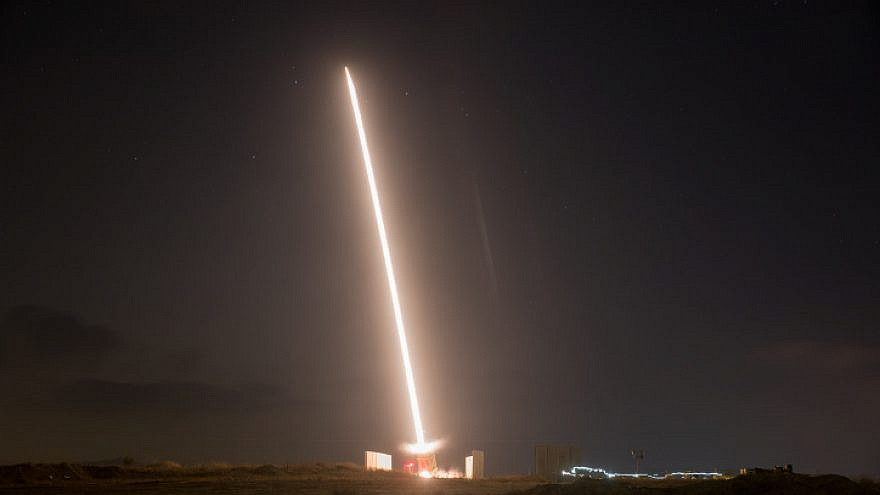The laser system will be integrated directly into the Rafael-made Iron Dome air defense batteries active since 2011.
By Yaakov Lappin, TPS
Within approximately 18 months, Israel is expected to deploy the world’s first laser defense systems, on borders that have Iranian-backed terrorist armies on the other side.
Gaza, Lebanon and Syria all made good candidates for the Rafael Advanced Defense Systems Iron Beam, which has been in development for nearly 20 years.
The laser system will be integrated directly into the Rafael-made Iron Dome air defense batteries, which have been in operation since 2011. Algorithms will determine when to activate the lasers and when to fire the kinetic Iron Dome interceptors, known as Tamir missiles, as well as which type of Tamir missile to launch. Some interceptors are equipped with special cameras, while others have on-board radar.
Both Iron Beam and Iron Dome can down rockets, mortar shells, unmanned aerial vehicles and missiles. However the laser system is designed to complement, not replace Iron Dome.
Iron Dome has intercepted around 95 percent of aerial threats fired from Gaza and heading for built-up areas in Israel, a rate it maintained during May 2023’s “Operation Shield and Arrow” against Palestinian Islamic Jihad. Nevertheless, the laser system has several relative advantages.
For one thing, the laser costs just a few dollars to fire (“the electric bill”), compared to the average cost of $50,000 per Tamir interceptor. Gazan terror factions Hamas and PIJ spend between $500 to $1,000 of Iranian funds on each rocket they build, depending on its range and size, giving them a financial advantage—until now.
In addition to being considerably cheaper than traditional air defenses, unlike them Iron Beam does not need replenishment. Furthermore, the laser strikes its target within seconds, far faster than kinetic interceptors.
On the other hand, the 100-kilowatt laser has a range of about eight to 10 kilometers (five to six miles), which is considerably shorter than that of Iron Dome, and each laser can engage a single threat at a time, unlike the Iron Dome, which can intercept multiple threats simultaneously.
In January 2020, the Israeli Defense Ministry announced three different laser programs: A ground-based laser to supplement Iron Dome, a mobile system to protect military units during maneuvers and an aerial system capable of downing threats from above. The aerial version will give Israel the ability to use lasers against rockets above cloud cover.
The real breakthrough in Iron Beam’s development came when engineers succeeded in creating electric-source laser systems instead of using the older chemical laser technology.
The parallel program to develop airborne laser interceptors also saw a breakthrough in 2021, when the Defense Ministry and Elbit Systems announced that a 100 kilowatt laser placed on a Cessna aircraft flying at 3,000 feet had downed 100 percent of UAVs that took part in the test.
The airborne laser interception range is approximately 20 kilometers (12 miles).
When combined, it is possible to envisage ground- and air-based lasers intercepting large numbers of projectiles at a fraction of the cost those projectiles cost to produce.
Iron Beam can also be used to provide site-specific protection for strategic locations such as power plants and ports.
Once the laser capability becomes established, Israel could also begin to focus on intercepting threats in enemy airspace. In Gaza’s case, that could mean that lasers placed on the border would not allow threats to cross into Israel, thereby theoretically reducing the need to activate rocket alerts.
Israel’s allies, meanwhile, are closely monitoring the development of this technology.
United States aerospace giant Lockheed Martin announced a partnership agreement with Rafael in December 2022 to develop an export version of Iron Beam for the American defense market.
MAKE THE LAND OF ISRAEL EVEN MORE BEAUTIFUL!
PLANT YOUR VERY OWN FRUIT TREES IN ISRAEL!
Farmers near the Gaza border lost family, friends and workers. Spring is here, and they desperately need help to replant the farms. Join us in blessing the People and Land of Israel.
“I will ordain My blessing for you…” (Leviticus 25:4)
